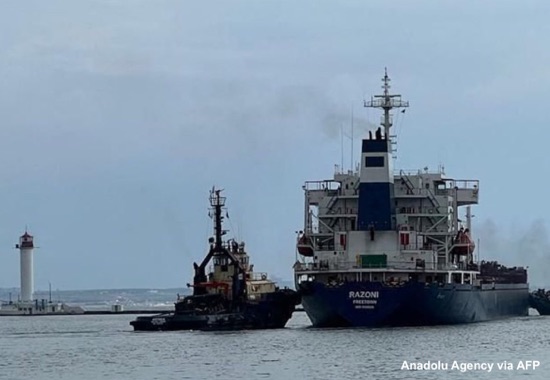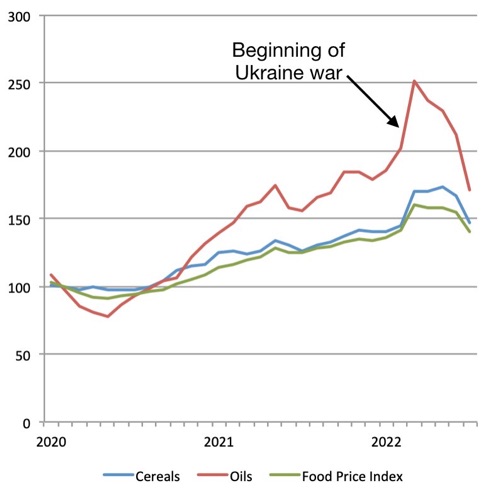News
13 August 2022
In the media: food crisis and invasion of Ukraine: what happened to Africa?
Since the beginning of the invasion of Ukraine by Russia, this horrible war has been presented in the media as the main cause of the current global food crisis.
On hungerexplained.org, we have had the opportunity to show that the food crisis (and the considerable increase in food prices that goes with it) had started long before the day when, on 24 February last, Russian troops crossed the Ukrainian border. We had also demonstrated that the most vulnerable countries to the halt of Ukrainian cereals were located in the Near East and in North Africa [read].
Surprisingly, most media, however, for a reason difficult to understand, persisted arguing that this halt would cause famine in Africa, despite available evidence and knowing that acute local food crises in Africa are, in their majority, linked either to conflicts or to extreme meteorological events. Furthermore, consumption of wheat is modest in Sub-Saharan Africa and generally limited to urban areas where food habits have been influenced first by colonisation and then by the adoption of western-type diets (baguette, bread and pasta, in particular).
It is worrying to observe that, since the conclusion of the agreement on 22 July last, under the aegis of the UN and Turkey, between Ukraine and Russia that makes it possible to get cereals slowly out of the ports of Odessa and Chornomorsk, reference to Africa virtually disappeared from the media.

Since the first cereal boat left Odessa, at the beginning of the month of August, information provided is limited to the goods transported (mainly maize for animal feed or agro-fuel manufacturing) and to the destination of the 14 boats that managed to leave Ukrainian ports, namely Lebanon, Egypt, the UK, Ireland, Italy, The Netherlands, China and Turkey. Where is Africa in this list? Note that no Subsaharan country has been among the destinations of these boats and that only one of them carried wheat (around 3,000 tonnes), soon heading for Turkey, and that there is an announcement that one ship is getting ready to supply Ethiopia with 23,000 tons [read].
Observers can only be intrigued by the almost generalised lack of any critical thinking and ethical standards by journalists who - with rare exceptions -, after having made a lot of noise around how the war in Ukraine would cause famine that would hit dramatically Africa, stopped overnight to mention the continent without any further explanation or comment, as if they were believing that their auditors were brainless and had a short memory.
The agreement of 22 July seems therefore to close a period of intense communication (of propaganda) around the “Ukraine war-induced famine” to be replaced by an episode more favourable to commercial concerns. Thus, an importer refused the maize brought by the first boat out of Odessa, destined to battered Lebanon - on the ground of late delivery - causing it to be rerouted towards Egypt.
For the time being, the opening up of the two Ukrainian ports and the small volumes exported from Odessa and Chomomorsk early August have not had a visible impact on world cereal prices [see graph here] that had already started falling in June, the decrease accelerating in July, probably on the basis of the ongoing and forecasted harvests in the northern hemisphere. Thus, between March and July 2022, the price index fell respectively by 11 79 and 18 points (or 15%, 32% and 12%) for cereals, vegetable oils and food commodities in general, according to FAO data [read] (see graph below).
Evolution of the FAO price indices
(January 2020-July 2022)
(2014-2016=100)

Source: based on FAO data
It is too early to say whether this fall will continue and what the level of food prices will be by the end of 2022, but it is probably that they will remain relatively high in the future [read].
(to be continued)
----------------
Note:
-
1.For the four boats that left Ukraine on 8 August, it was said that “they were carrying more than 161,000 tonnes of maize and food products to Turkey, China and Italy”.
—————————-
Earlier articles on hungerexplained.org related to the topic:
-
•Opinions: Sanctions Now Weapons of Mass Starvation by Anis Chowdhury and Jomo Kwame Sundaram, 2022.
-
•Food crises: A consequence of disastrous economic policies, 2012.
Last update: August 2022
For your comments and reactions: hungerexpl@gmail.com


